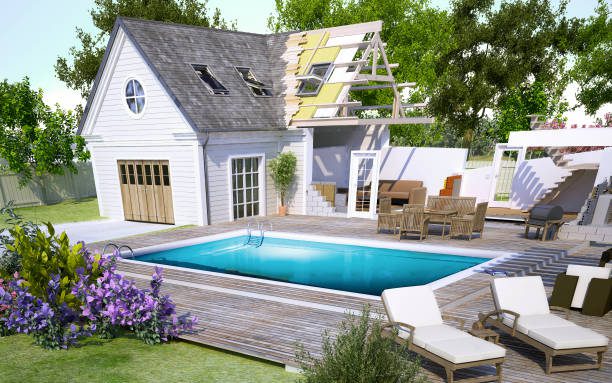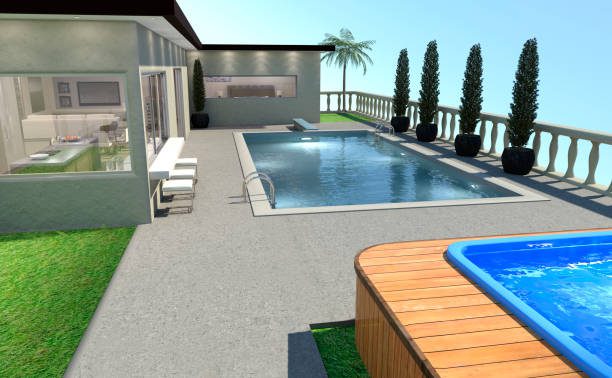Compact Pool Design Ideas for Eastvale, CA Homes, Small Backyard, Big Dreams
Compact Pool Design Ideas, You don’t have to give up your desire to own a pool just because you live in Eastvale, California, where space might be scarce. Even the tiniest backyard may become an opulent haven with imaginative designs and contemporary pool construction methods. Exotic Water Worlds specializes in small pool designs that are ideal for little urban areas since they optimize both elegance and practicality. Regardless of the size of your yard, these creative pool ideas can help you get the most out of it!

Why Choose a Compact Pool?
For Eastvale residents who want to create a cool retreat without giving up a lot of outside area, small pools are perfect. Compact pools are a sensible option for homeowners looking for a controllable, cost-effective solution since they require less upkeep and use less energy than regular pools. Any aesthetic or practical desire may be accommodated by customizing a tiny pool with a variety of shapes, materials, and styles.
Compact Pool Design Ideas:
1. Plunge Pools:
Plunge pools are shallow, smaller pools that are ideal for relaxing and cooling off rather than swimming. They may be complemented with elements like jets, waterfalls, or illumination to create a calming effect, and they readily fit into small places.
Advice: To make it a communal area for events, think about putting built-in seats around the perimeter.
2. Lap Pools:
Perfect for fitness enthusiasts: Exercise may be done in a small area with a narrow lap pool. These pools are ideal for backyards that are rectangular or small since they are longer than broad.
Advice: Installing a “fast lane” current system, which enables you to swim against a stream for a stationary swimming experience, can help you save even more room.
3. Spool Pools (Small Pool + Spa):
The best of both worlds: A spool pool combines the leisure of a spa with the practicality of a small swimming pool. Since these little pools frequently include jets, they may be heated and utilized as a hot tub in the winter.
Advice: To create an area that can be used for both socialization and leisure, add bench seating and massage jets.
4. Geometric Pools:
Clean and modern: Geometric pools with perfect angles and straight lines maximize available area and give any backyard a contemporary feel. Their straightforward designs make them easy to fit into small areas, and they appear elegant when combined with modest landscaping.
Advice: For a chic, upscale look, surround your geometric pool with wood decking or natural stone.
5. Naturalistic Pools:
A merge with nature: Often containing plants, rocks, and even little waterfalls, these pools are designed to resemble natural ponds and provide a calm setting. Due to its ability to blend in seamlessly with the surrounding landscape, this style is ideal for compact yards.
Tip: To improve the natural sense and create a tranquil haven, use organic materials like pebbles, stones, and indigenous plants.
6. Infinity Edge Pools:
Infinity pools: are a great way to add luxury to a tiny space, especially if your yard has a view or a minor slope. The pool appears larger than it actually is because of the opulent effect of the infinity edge.
Advice: To make it even more noticeable at night and to add ambiance and safety, install LED lighting along the edge.

Space-Saving Features for Compact Pools:
Multipurpose Decking: To maximize both use and beauty, use decking as a place to sit and a place to store pool necessities.
Built-In seats: Seating is created within the pool without requiring additional room by installing built-in seats or ledges.
Compact Water Features: To make the pool feel more like an oasis, add a little luxury with bubblers or waterfalls that don’t take up much space.
Maintenance Tips for Compact Pools:
Although smaller pools need less upkeep than bigger ones, frequent cleaning and water balancing are crucial. Here are some pointers for effective upkeep:
Employ a Pool Cover: By keeping debris out and reducing evaporation, a pool cover makes maintenance simpler.
Automated equipment: Make an investment in filtration or pool cleaning equipment that can effectively manage the reduced volume.
Energy-Efficient Heaters: Smaller, energy-efficient systems may be used to heat compact pools, lowering your utility expenses.
Benefits of a Compact Pool:
Compact Pool Design Ideas, Compact pools consume less water and chemicals, are less expensive to install, and have reduced continuing expenditures. You may spend more time unwinding and enjoying your environment because tiny pools are also simpler to clean and maintain.

Conclusion:
Regardless of the size of your location, we at Exotic Water Worlds make your idea a reality. Allow us to assist you in designing a sumptuous yet little pool that will turn your backyard into a revitalizing retreat. Get in touch with us right now to talk about your ideal pool and to discover all of your options.
Q1: How much space do I need for a compact pool in Eastvale, CA?
Answer: Compact pools are highly versatile and can fit in areas as small as 10×10 feet, depending on the design. We recommend working with our designers to assess your available space and find the best option.
Q2: What are the costs associated with building a compact pool?
Answer: Costs vary based on materials, design, and features, but compact pools generally range from $20,000 to $50,000. Contact Exotic Water Worlds for a customized estimate based on your preferences.
Q3: Can I add a hot tub to a compact pool?
Answer: Yes! Many homeowners opt for a “spool” – a combination of a pool and spa – which provides both a place to cool off and a heated area for relaxation.
Q4: Are compact pools difficult to maintain?
Answer: Compact pools are easier to maintain than larger pools because they use less water and require fewer chemicals. Routine cleaning and monitoring of water balance are still essential, but maintenance time and costs are generally lower.
Q5: How long does it take to install a compact pool?
Answer: Installation time varies, but compact pools typically take about 6-8 weeks from design to completion, depending on permitting and weather conditions.
